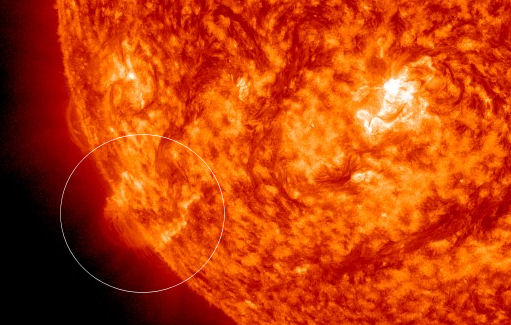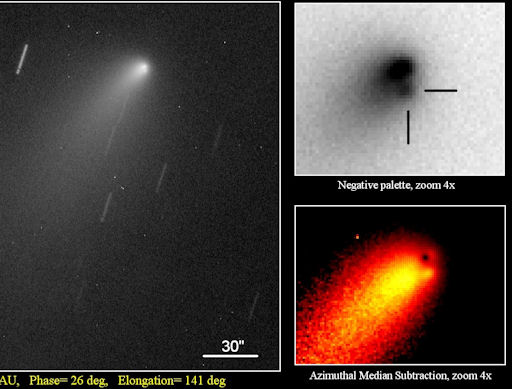MOSTLY QUIET WITH A CHANCE OF FLARES: Solar activity is low. With no sunspots actively flaring, the sun's x-ray output has nearly flatlined--for now. Strong flares are still a possibility. Sunspot AR1598 has a delta-class magnetic field that harbors energy for M-class eruptions. Solar flare alerts: text, voice.
BE ALERT FOR MOON HALOS: The Moon is waxing full and the northern hemisphere is experiencing the deepening chill of autumn. That means it's time to be alert for Moon halos. Martinsh Taube photographed this specimen last night in Valmiera, Latvia:
"We were on a late night walk through the city when we saw it," says Taube.
Moon halos are caused by ice in high clouds. Moonlight passing through six-sided crystals is bent into a luminous ring 22o in radius; the fuller the Moon, the brighter the halo. The Moon will be nearly full on Oct. 28th and completely full on Oct. 29th, so those are good nights to look. More specimens may be found in the gallery:
Realtime Space Weather Photo Gallery
CANYON OF FIRE: A filament of magnetism snaking around the sun's southeastern limb erupted on Oct 26th. The blast created a "canyon of fire" in the sun's lower atmosphere. Click on the circle to animate the event:
The glowing walls of the canyon are formed in a process closely related to that of arcade loops, which appear after many solar flares. Stretching more than 250,000 km from end to end, the "canyon" traces the original channel where the filament was suspended by magnetic forces above the stellar surface.
As erupting magnetic filaments often do, this one launched a coronal mass ejection (CME) into space. The Solar and Heliospheric Observary recorded the expanding cloud: movie. The CME does not appear to be heading for Earth or any other planet.
Realtime Space Weather Photo Gallery
A COMET IN TROUBLE? Amateur astronomers have been keeping a close eye on Comet 168P/Hergenrother since October 1st when it suddenly brightened 500-fold, from 15th to 8th magnitude. At the time, the comet was making its closest approach to the sun (1.4 AU). Some observers speculated that solar heating caused the fragile comet to break apart. On Oct. 26th, a group of astronomers found evidence to support this idea. "Using the Faulkes North (F65) telescope," writes Ernesto Guido et al., "we detected a fragmentation in Comet 168P."
"Our images, taken on Oct. 26th, reveal the presence of a secondary nucleus, or fragment, about two arcseconds away from the main central condensation of comet 168P." This is probably a chunk of rocky ice emerging from the haze of gas and dust that surrounds the main nucleus, still hidden inside. Comets are notoriously fragile, so its no surprise that Comet 168P/Hergenrother is breaking apart in this way.
The only question is, what happens next? Will the comet spit in two, with two heads and two tails, one tracking the fragment and the other tracking the parent? Or is this the prelude to a more complete disintegration? Amateur astronomers are encouraged to monitor developments while the comet remains bright enough to see through backyard telescopes. Here are the comet's coordinates. For best results, we recommend the Comet Hunter Telescope.

![]()
Solar wind
speed: 348.6 km/sec
density: 1.0 protons/cm3
explanation | more data
Updated: Today at 1607 UT
![]()
X-ray Solar Flares
6-hr max: C1 1001 UT Oct28
24-hr: C1 0805 UT Oct28
explanation | more data
Updated: Today at: 1600 UT
![]()
![]()
![]()
Daily Sun: 27 Oct 12
![]()
![]()
Decaying sunspot 1598 poses a slim threat for M-class solar flares. Credit: SDO/HMI





